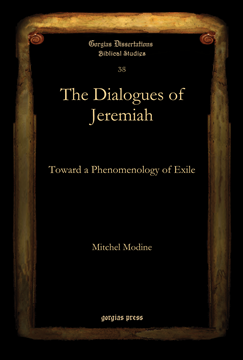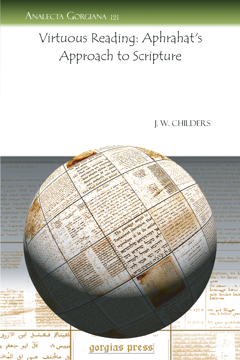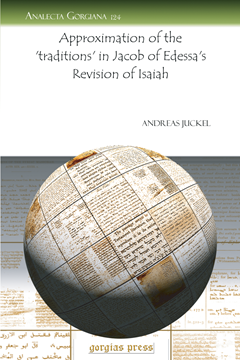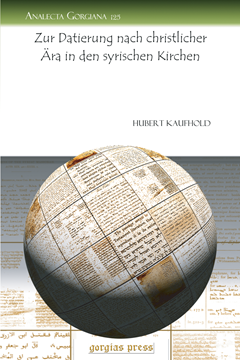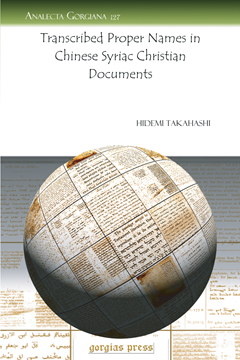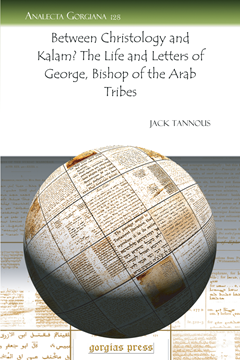The Dialogues of Jeremiah
Toward a Phenomenology of Exile
Series: Gorgias Biblical Studies 38
ISBN: 978-1-60724-028-0
An emerging consensus maintains that the exile was not as extensive as the Old Testament claims. However, that it held singular importance for the book of Jeremiah is beyond question. Modine argues that Jeremiah represents a range of options for understanding and responding to the events surrounding the destruction of Jerusalem and its temple. This volume reads the diverse contents of Jeremiah as a kind of dialogue between competing perceptions of the exile. The author argues that coherence is to be found precisely in the incoherent, as it reflects the communal trauma of exile.
$161.00 (USD) $96.60 (USD)
Virtuous Reading
Aphrahat’s Approach to Scripture
Series: Analecta Gorgiana 121
ISBN: 978-1-60724-035-8
The epistemology of the mid-fourth-century Christian scholar in Persia, Aphrahat, presumes that the human mind and the task of biblical interpretation are caught up in a dynamic experience of Christian spiritual transformation. In short, for the Persian Sage, good Bible interpretation requires nothing less than the total person—inner and outer, in community and before God. In Aphrahat’s Demonstrations, we encounter a scholar who not only presents this remarkably integrated set of ideals but is also an impressive practitioner of them.
$37.00 (USD) $22.20 (USD)
Approximation of the ‘traditions’ in Jacob of Edessa’s Revision of Isaiah
Series: Analecta Gorgiana 124
ISBN: 978-1-60724-036-5
This article contributes to the knowledge of Jacob of Edessa’s (d. 708) Old Testament revision by editing twenty texts (a total of 80 verses) from the Book of Isaiah and comparing them with the Greek recensions of the Septuagint, with the Peshitta, and the Syrohexapla. Two special features are introduced to set out Jacob’s revision technique in some detail: 1. comparison with an earlier undeveloped stage of Jacob’s revision extant in Ms Add 17,134 of the British Library; and 2. the distinction (by different colours and fonts) of the ‘traditions’ involved in the definite stage of his revision. Both features point to the emphasis given to the Peshitta in translating the substantial Greek text of the Old Testament.
$43.00 (USD) $25.80 (USD)
Zur Datierung nach christlicher Ära in den syrischen Kirchen
Series: Analecta Gorgiana 125
ISBN: 978-1-60724-038-9
The Christian era in Syriac and Arabic sources does not always correspond with the western calculations. Until quite recently the members of the Syriac churches used the era of the Seleucids (of Alexander the Great; East and West Syrians) as the era of the creation of Adam (Melkites). The use of the Christian era became more common from the 16th century, due to the closer contacts between the Oriental and the Latin churches.
$43.00 (USD) $25.80 (USD)
Transcribed Proper Names in Chinese Syriac Christian Documents
Series: Analecta Gorgiana 127
ISBN: 978-1-60724-039-6
Christianity reached China in its Syriac guise in the seventh century. Christian documents written in Chinese which have come down to us from the period of the Tang Dynasty contain a large number of proper names which are, or appear to be, transcriptions of Syriac names. In this paper, originally published in Malphono w-Rabo d-Malphone: Studies in Honor of Sebastian P. Brock, the author provides a list of the transcribed proper names with their modern and reconstructed Middle Chinese pronunciations, together with the suggestions made by scholars in the past for the original forms of these names.
$38.00 (USD) $22.80 (USD)
Between Christology and Kalām? The Life and Letters of George, Bishop of the Arab Tribes
By Jack Tannous
Series: Analecta Gorgiana 128
ISBN: 978-1-60724-040-2
A translator of Aristotle and friend of Jacob of Edessa and Athanasios of Balad, George, Bishop of the Arab Tribes (d. AD 724) was an important figure in the history of the life and thought of the Syrian Orthodox Church. This article offers a study of the first three of George’s eleven extant letters and relates them to the larger Christian and Islamic context of his day. It will be of interest to students of Greek patristics, Syriac Christianity, and early Islamic history.
$41.00 (USD) $24.60 (USD)
